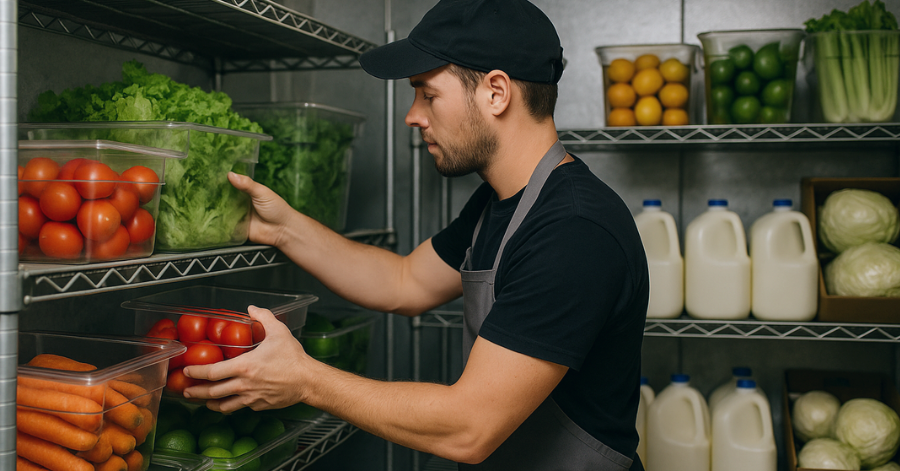Running a restaurant means juggling a lot of tasks, and inventory may not feel like the most exciting one. However, implementing the FIFO (First-In, First-Out) inventory method can transform your stockroom into a well-oiled machine. Basically, FIFO means using your oldest food and beverage stock first, and placing new deliveries behind existing products to ensure proper rotation, especially for perishable items.
This approach does more than just keep your shelves organized, it’s a powerful way to cut waste, protect food quality, and boost profits. In this blog, Sculpture Hospitality will take a closer look at the key benefits of using FIFO in restaurants.
Key FIFO Benefits at a Glance
FIFO is an important best practice that supports a more profitable, efficient inventory process, especially when paired with consistent inventory tracking and analysis.
Reducing Food Waste
One of the biggest advantages of FIFO is the ability to cut down on food waste. By consistently using the oldest ingredients first, you prevent items from expiring in the back of shelves or fridges, many of which can go unnoticed.
This method ensures you're always rotating stock efficiently, significantly reducing the amount of inventory that must be thrown away. Less spoilage means lower food costs, fewer garbage runs, and real savings in both money and time.
Boosting Food Quality and Customer Satisfaction
FIFO isn't just about saving money, it’s about serving the best possible dishes to your customers. Fresh ingredients make a real difference when it comes to taste, texture, and overall dining experience.
By prioritizing FIFO, you ensure your customers consistently enjoy meals made with top-quality ingredients. Restaurants that prioritize fresh flavours often see higher customer satisfaction rates, positive reviews, and more repeat business.
Freshness can even justify higher menu prices; after all, quality ingredients result in premium offerings.
Enhancing Profitability and Cash Flow
While FIFO is a physical inventory rotation strategy, it indirectly supports profitability. By reducing spoilage and encouraging faster stock turnover, you can lower your cost of goods sold (COGS) over time and avoid tying up cash in unused items.
Faster-moving inventory also leads to better purchasing decisions and less risk of waste — two things that make your business more agile and financially healthy.
Ensuring Food Safety and Regulatory Compliance
Food safety is non-negotiable, and FIFO makes it easier to meet health regulations.
Implementing FIFO reduces the risk of serving expired or unsafe food, supporting compliance with HACCP, FDA, FSEP, and local food safety standards. It also helps health inspections run smoother by providing a clear and logical method for stock rotation and expiration tracking.
As noted by High Speed Training, proper stock rotation reduces cross-contamination risks, ensures better hygiene, and demonstrates best practices to auditors.
Simplifying Inventory Management
With FIFO, inventory management becomes far less stressful and much more intuitive. Staff can easily identify which products to use next without second-guessing or cross-checking every item.
Incorporating FIFO leads to a more organized kitchen, reducing ordering mistakes, and streamlines the process of a full inventory count. It also allows teams to focus more on preparing quality meals and excellent service rather than scrambling to manage stock at the last minute.
Why WAC May Be Better Than FIFO for Managing Non-Perishable Inventory
While FIFO is a strong and smart financial strategy, other restaurant inventory methods can also be recommended, especially when it comes to managing liquor inventory in your bar. One of these is WAC, or weighted average cost.
When it comes to WAC, the value of inventory items isn’t based on when they were purchased and what the price was, but instead averages out the cost of the number of units left in inventory. It helps with price fluctuations, especially when there is a large supply of similar items. One downside to using WAC is that there is an assumption that the items are identical or very similar, which isn’t the case.
WAC is determined by calculating the total cost of inventory and dividing it by the number of units available for sale. FIFO can still be used for managing bar inventory like fresh garnishes, beers, certain wines, and more.
Quick Tips for Implementing FIFO in Your Restaurant
Want to implement FIFO effectively? Here are a few simple steps to get started:
- Label everything: Pair FIFO with a simple labelling system. Mark each delivery with the date received and place new stock behind existing items immediately.
- Stock by rotation: Always place newer inventory behind older inventory.
- Use the oldest items first: Train your staff to pull stock from the front to ensure older items are used first.
- Check stock regularly: Conduct weekly or daily checks for expired or soon-to-expire items.
- Educate your team: Make FIFO a core part of staff training to ensure consistent application across your kitchen.
Following these basic steps can turn FIFO from theory into an everyday habit.
Final Thoughts: FIFO Is a Small Change with Big Results
Implementing a FIFO system is a small operational shift that can deliver major benefits: better food quality, stronger customer loyalty, reduced waste, and healthier profits.
Ready to see the impact for yourself? Start by introducing FIFO into one part of your kitchen today, such as your fresh produce or dairy stock, and build from there.
Need expert guidance? Connect with our inventory specialists to optimize your inventory management systems for long-term success.










